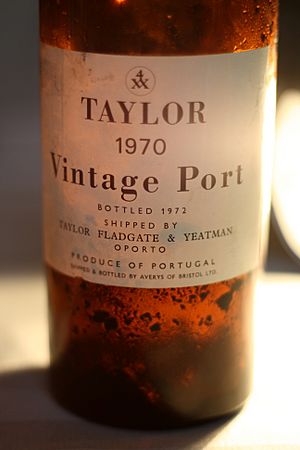Sediment (wine) facts for kids

Sediment is the solid stuff that settles at the bottom of a wine container. This can be a bottle, a large tank, or a barrel. It's a mix of different things that come from the grapes and the winemaking process.
Contents
What is Wine Sediment?
When wine is first made, sediment mostly includes tiny bits of dead yeast cells. These are called lees. It also has small pieces of grape skin, pulp, and seeds. As wine gets older, other things can settle out. These include tiny crystals called Tartrates. Red wines can also form colored bits from the grapes called phenolic polymers. Sometimes, special materials added to make the wine clear also become part of the sediment.
Why Does Sediment Form?
Sediment forms for different reasons depending on the wine. In new wines, it's natural for grape bits and yeast to settle. Winemakers often try to remove most of this to make the wine clear. However, some wines are made to age for a long time. These wines often keep more of the natural compounds from the grapes. As these wines get older, these compounds slowly combine and settle at the bottom. This process helps the wine develop special smells and flavors, which experts call "bouquet."
Is Sediment Bad?
Many people today are not used to seeing sediment in wine. They might think it means the wine is bad, but this is often not true. In fact, finding sediment in a bottle can be a sign of a high-quality wine. It often means the wine has aged well for many years. Winemakers try to remove sediment from most wines. This is especially true for wines meant to be drunk soon after they are made. But for wines made to age, sediment is a normal and often good sign.
Dealing with Sediment
If you have a wine with sediment, you can pour it carefully. This helps leave the sediment behind in the bottle. Another way is to use a Decanter. A decanter is a special glass container. You pour the wine into it slowly, leaving the sediment in the original bottle. This makes sure you only drink the clear wine.
See also

